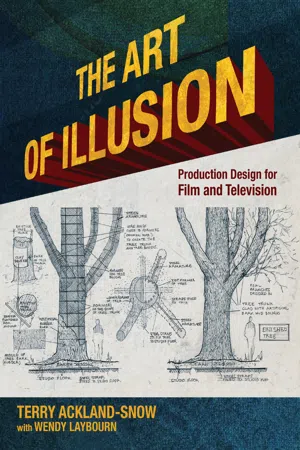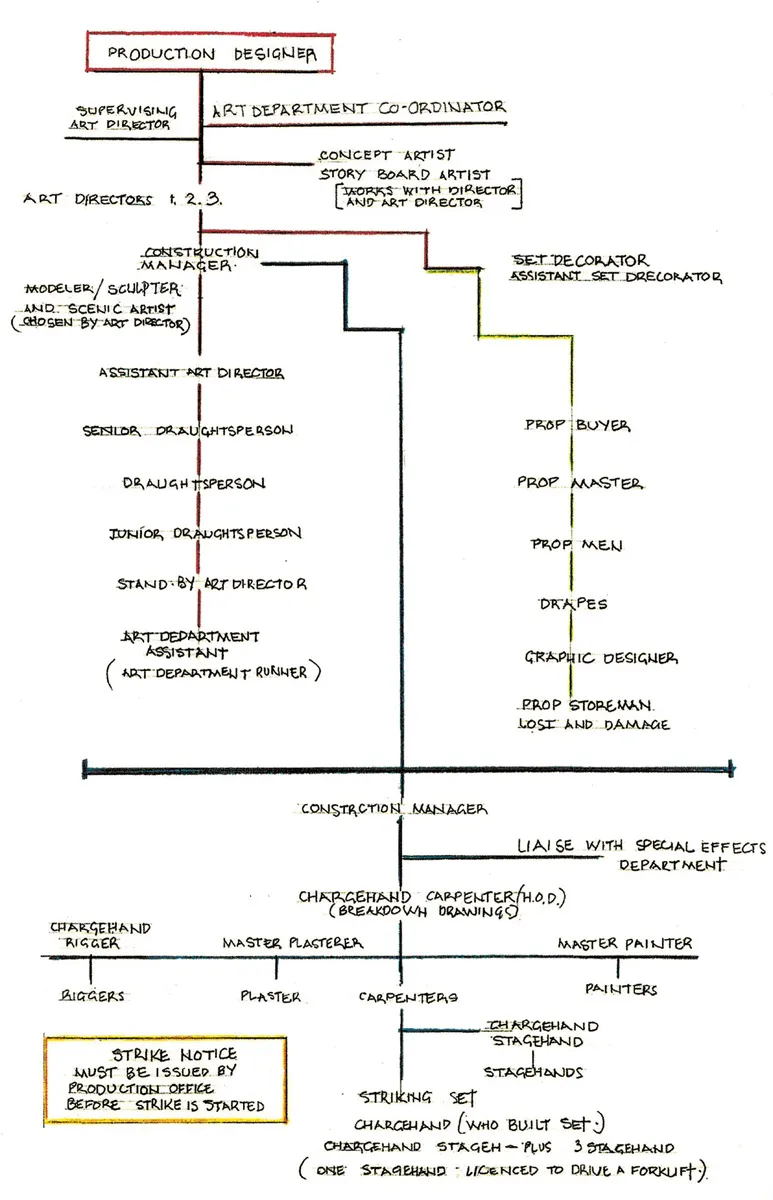![]()
CHAPTER 1
THE ART DEPARTMENT
Feature film production is an industry full of multitalented artists and artisans, but it is also a heavily financed and controlled business in every sense. It is not a career to enter into light-heartedly, so it is important to understand the pressures that will come with being part of a film production crew.
A professional film crew is a well-practised and creative machine where everyone shows up to work knowing exactly what to do and when to do it. In film production, every artist to some extent is a technician, using technology to turn ideas into reality. An educational environment is ‘safe’ by design, free from the unpredictable situations that working life throws at you and free from the need to make a living. There are very few people who can leave education fully capable of working in the professional film world as an accomplished creative or technician. That takes life experience, which can only be gained once you start working.
There are so many facets to the process of producing a film or a television drama that jobs, skills and technologies are very often intertwined. This book is all about working in the Art Department, which houses the people who create a film’s look. They build sets and dress them. They have the skills of an architect, an artist, an interior designer and a world-class shopper. However, everyone in the Art Department must have a working knowledge of the skills and responsibilities of all the crews they come into contact with, because they will have a direct influence on the design process.
Essentially, the Art Department is the ‘hub’ around which the film crew works. It provides the creative template on which the other departments depend, providing a base for the exchange of creative ideas, where opinions and options are discussed and formalized. The work and planning undertaken in the Art Department enables the crew to build and create the illusion that the audience will see on the screen.
THE ART DEPARTMENT STRUCTURE
Art Department Structure.
The head of the Art Department is the Production Designer, who is fully supported by the Art Director. These two roles are often confused, so what is the difference? The Production Designer is in charge of everything artistic. He or she will have been chosen by the Director in the early days of pre-production as the most suitable for and the most compatible with the Director’s vision for the film. They will work with the Director and the other Heads of Departments from pre-production right through until the final scene is captured.
The Art Director works directly for the Production Designer and looks after the Art Department on a day to day basis, including the Construction Crew, which can number 200–300 craftsmen and women on a major feature film.
Both the Production Designer and the Art Director will have worked their way through the various levels of the Art Department and, essentially, both will have a firm understanding of architecture and materials. However, the Production Designer does not necessarily need to have the same technical qualifications as the Art Director. The Production Designer creates the detailed sketches and drawings, both of interiors and exteriors, which then fall to the Art Director and his team to extend into blueprints for the Construction Manager to work from.
Within the Art Department, the Art Director is the leader, the translator of sketches and drawings into working blueprints, the intermediary between the Production Designer, Director and Construction Crew, as well as the protector of everyone working in his department. He will, in return, demand absolute loyalty and discretion from those around him.
Art Department Structure showing how the Art Department ‘hub’ interacts with Special Physical Effects and Construction.
The Director is the absolute ‘boss’ of the creative film crew, but how an individual Director interacts with the Art Department will depend on their personality. Some will only be concerned with the performances and the action on set and will leave much of the overall design and construction to the Production Designer and the Art Department, whilst others will be more ‘visual’ and want to have a hands-on approach. Whichever version of Director is in control of the film, the Art Director will have to be the ultimate diplomat, whatever the challenges.
Breakdown of crew for a large-budget feature film.
Breakdown of crew for a medium-budget film.
Breakdown of crew for a low-budget short film.
The Production Designer and the Art Director are co-dependent. In any argument between the Designer and the Director regarding, for example, last-minute location or set changes that are already designated and well under way and which may be costly or tricky to reorganize, the Art Director should, very diplomatically, support the Designer with quick sketches, original material and, very importantly, budget and scheduling information, to back up the Designer’s argument.
The final responsibilities of the Art Department are to the studios and locations where the sets will be constructed. Within the studio complexes, there will be specific rules and regulations that have to be taken into consideration. The same applies to locations, so the Art Director, with the Location Manager, has to have a basic knowledge of that country’s laws, as well as the specific needs of the local regulations.
Many factors contribute to every image seen by the audience on the cinema screen and each department of the film unit bears responsibility for a particular aspect of the content. All will make their individual and collective contribution to the convincing portrayal of the action and the story, bearing the responsibility of making sure that the overall concept adds to the cinematic illusion, so the relationship which the Designer and Art Director develop with the Director and the other Heads of Department is of critical importance.
There are many things to assimilate when you start working in film. Every production is a work of illusion, created over a period of time by a multitude of artists and craftsmen. The Art Department is going to be your home and the people working in and around it your family for the duration of the shooting process, so be prepared to work in close contact with this crew for twelve to eighteen hours a day, six to seven days a week, anywhere from three to six months in any one year. The ability to ‘get on’ with everyone is essential, not only to make your life as part of the crew easier, but a pleasant and willing personality makes you a much more employable asset to the Art Director when he chooses the crew for his next film.
UNDERSTANDING THE JOBS IN THE ART DEPARTMENT
Although initially working alone with the Director, the Designer will have to determine what resources he needs to realize the design necessary for the film. After the initial reading of the script, he will have a rough idea of the basic technical problems he will face and the Director’s own interpretation will present other problems – such as insisting on using distant locations or extensive special effects.
However, the Designer will have a very skilled team of technicians and craftsmen and women to help him. The following is a list of the primary categories of these professionals and a breakdown of their responsibilities.
* Please note that the following titles marked with an asterisk are generic terms and are used to describe both male and female practitioners. All roles can be filled by either a man or a woman and references to ‘he’ are for convenience only.
Production Designer
As a major Head of Department, the Production Designer works very closely with the Director, Art Director, Construction Manager, Costume and Make-up Designers and the Director of Photography, playing a crucial role in helping the Producer and Director to achieve the visual requirements of the film.
A great deal of work and imagination from the Art Department goes into constructing the appropriate backdrop to any story and into selecting and constructing the appropriate sets. Working from the script or screenplay, the Designer assesses the visual qualities that will create the right atmosphere for the performers to bring the story to life. After preparing a careful breakdown of the script, Production Designer meets with the Director to discuss how best to shoot the film – whether to use studio sets and/or locations; what should be built and what could be adapted; whether there is a visual theme that recurs throughout the film; whether there are certain design elements that may give an emotional or psychological depth to the film; and when and where special physical effects and visual effects (CGI) should be used. These discussions are followed by an intense period of research, during which the Production Designer and his Specialist Researchers source ideas from books, photographs, fine art and the internet.
In the pre-production stage, the Production Designer illustrates his vision for each set and location with sketches and models as a guide. These illustrations will outline a colour palette, period, texture and tone to which everyone adheres. Working closely with the Producer and Director, the Designer narrows down the requirements and sets the Art Department budget.
During principal photography, the Production Designer acts as a co-ordinator to maintain the overall aesthetic vision. They influence decisions made by the Lighting, Wardrobe, Hair and Make-up and Special Effects Departments.
Supervising Art Director
The Supervising Art Director acts as the ‘eyes and ears’ of the Production Designer and the Art Department on big-budget films. The sheer complexity of the work and the speed of feature film production mean that it is often unrealistic for the Production Designer to depend on one Art Director to cover all the sets. Big science-fiction epics or action films might have several locations, using second and third shooting units, plus models and miniatures and action sequences, all of which may require dedicated Art Directors, who will work under the watchful eye of the Supervising Art Director.
Construction Manager
The Construction Manager is the Head of Department for the Construction Crew and is responsible for interpreting the Art Department’s plans and designs to establish the number of sets required, their size, design, colour and texture – and to turn those blueprints into fully functional film sets.
Hired by the Production Designer to oversee the entire process of set building, from initial planning through to the final coat of paint on the finished sets, they w...





